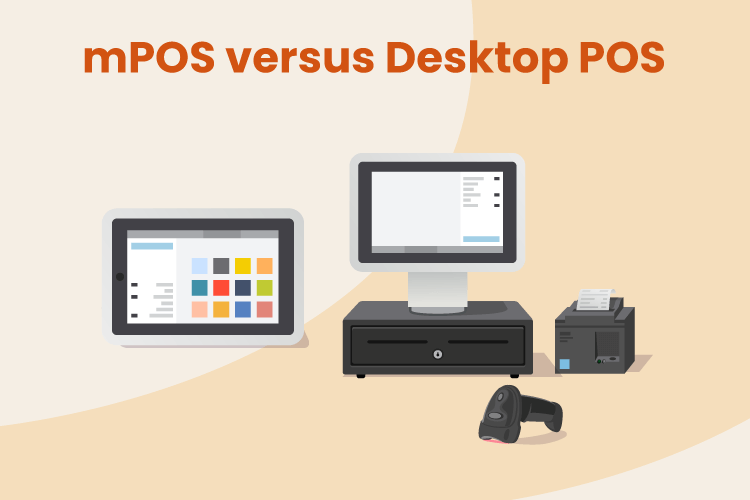There is a lot of confusing POS terminology out there. The industry is evolving at an incredible rate, with new features and methods coming out seemingly every month. Innovation has made technology more powerful for businesses, but it doesn’t come without some understandable confusion.
One item of confusion we’ve heard a lot of customers mention is the difference between POS and mPOS and mobile payments. And it’s a critical part of the retail solution to understand. Without a good grasp of what you need and the options you have, shopping for the right point of sale system becomes much more difficult.
So let’s take a look at the differences between these three terms and what they mean for your store. It’s time to get your business set up for growth.
How Does a POS System Work?
A point of sale is a broad term referring to both hardware and software. Traditionally, a POS was the cash register and tools used to accept forms of payment. While this is still part of a POS system, its roles have expanded to many more features.
The POS hardware is the physical pieces of equipment used in facilitating a transaction. For most businesses, this includes several key items:
- Desktop or tablet computer
- Cash Drawer
- Receipt printer
- Scanner
- Credit card machine
Point of sale software is what runs the operation. Modern POS software is cloud-based, so all data is stored remotely and securely. But the software can also complete an array of tasks aside from ringing up a customer, including the following:
- Inventory management
- Customer relationship management and loyalty programs
- Anti-theft features
- Sales reporting and metrics
- Employee permissions
- Payroll and accounting
- Data transfers for multiple locations
- Returns and refunds
- Promotions and discounts
- Split payments and gift cards
With the software and hardware together, your POS system serves as the center of your business operations. Even better, your point of sale can help your business grow and expand by providing you with remarkable insight into your business’s operation.
What’s the Difference Between POS and mPOS Then?
While a point of sale, or POS, is a broad term referring to the entire solution, an mPOS simply stands for mobile point of sale. These modern mobile solutions are built for tablet use, offering a more flexible alternative to traditional desktop POS systems. Usually, mPOS systems are linked to traditional transaction peripherals, including credit card machines, receipt printers, or scanners.
It’s cloud technology that has empowered mPOS capacities. Traditionally, all transactional data was stored at the site of the cash register. The owner or manager would be responsible for manually tracking all sales and inventory throughout the day.
Now, of course, POS systems can track everything automatically in real-time. And mPOS solutions make this even easier. The mobility aspect of an mPOS applies to both the software and hardware.
- On the hardware end of things, mPOS machines can be run on tablets, allowing you to process a transaction from anywhere on the floor or to open a new lane/terminal quickly.
- mPOS software means that you can access your store’s data from any internet-connected device from any location.
These solutions improve the customer experience, make it easier for associates and cashiers to perform their job, and add critical flexibility to operations.
How Are Mobile Payments Different?
While mPOS refers to the point of sale software and hardware, mobile payments is all about how the customer can pay for a certain item. There are more and more options available every year.
Payment through a mobile device (most commonly a smartphone) is becoming more popular. These payments can be made through various mobile wallets. This payment software provides consumers with a digital credit or debit card. The payment information is read by a device that uses near-field communication (NFC) to read the card data.
Retailers must be prepared to accept this modern form of payment. Get the proper credit card machine and make sure your POS is compatible with mobile payment technology. The most popular mobile wallets are Apple Pay and Google Pay.
Money transfers are also a common method of mobile payments. Money transfers through PayPal, Venmo, Facebook, or a variety of other sources allow you to send money directly into a bank account. This is built for personal transfers, but many small businesses use this technology as a type of mobile payment, too.
Contactless credit card machines built for mobile payments are the recommended solution for the vast majority of businesses because they are more reliable and able to tie into to your POS solution.
Get Your Business Set Up With the Right mPOS Solution
Hopefully, this clarifies any questions you have about POS, mPOS, and mobile payments. Now, it’s time to figure out exactly what your business requires.
mPOS systems are built to facilitate fast and secure transactions, first and foremost. But they also allow businesses to scale by providing in-depth software features. To find out more about how an mPOS can help your business succeed, give us a call at KORONA POS. We’ll walk you through our mobile, cloud-based POS system. Set up an unlimited free trial and set up a personalized demo with one of our product specialists. Click below to get started with KORONA POS.
Get started with KORONA POS today!
Explore all the features that KORONA POS has to offer with an unlimited trial. And there’s no commitment or credit card required.












